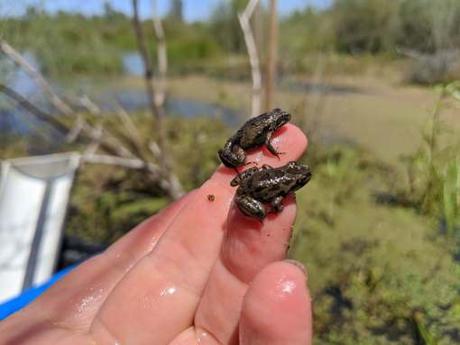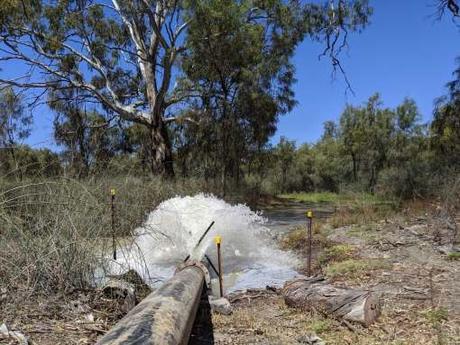
Crinia parinsignifera (top) and Limnodynastes tasmaniensis (bottom). Photo: Kate Mason
The amphibian class is diverse, and ranges from worm-like caecilians to tiny frogs that live their entire lives within bromeliads high in the rainforest canopy. Regardless of form or habit, all share the dubious honor of being cited as the world’s most endangered vertebrate taxon, and 41% of the species assessed are threatened with extinction. Rapidly changing climates will further exacerbate this situation as amphibians are expected to be more strongly affected than other vertebrates like birds or mammals.
This peril stems from a physiological dependence on freshwater.
Amphibians breathe (in part) through their skin, so they maintain moist skin surfaces. This sliminess means that most amphibians quickly dry out in dry conditions. Additionally, most amphibian eggs and larvae are fully aquatic. One of the greatest risks to populations are pools that dry too quickly for larval development, which leads to complete reproductive failure.
This need for freshwater all too often places them in direct competition with humans.
To keep pace with population growth, humans have engineered a landscape where the location, and persistence of water is tightly controlled. In seeking water availability for farming and amenity, we all too often remove essential habitats for amphibians and other freshwater fauna.
To protect amphibians from decline and extinction, land managers may need to apply innovative techniques to support vulnerable species. With amphibians’ strong dependence on freshwater, this support can be delivered by intelligently manipulating where and when freshwater appears in the landscape, with an eye to maintaining habitats for breeding, movement and refuge. A range of innovative approaches have been attempted to date, but they are typically developed in isolation and their existence is known only to a cloistered few. A collation of the approaches and their successes (and failures) has not occurred.
In our latest paper, we used a systematic review to classify water-manipulation techniques and to evaluate the support for these approaches.
Extending the duration of breeding pools
The most frequently attempted and supported approach was extending the duration of breeding pools.
Successful approaches were:
- excavating pools to increase their depth prior to filling
- installing a pond liner prior to filling, and
- pumping water into pools to extend their duration
All reported examples supported metamorphosis of amphibians in situations that would have otherwise resulted in premature pool drying and complete recruitment failure.
Spraying water into the landscape
Several projects sprayed water into the environment, but their goals differed.
Following the installation of a hydroelectric dam in Tanzania, the Kihansi spray toad, which lived exclusively in the spray zone beneath the Kihansi Falls, was left without habitat. Installing several kilometres of hoses and sprinkler nozzles returned spray to 2900 m2, and in the first two years of sprinkler operation, toad populations increased.
Sadly this did not last and the remaining population dwindled and is now extinct in the wild. Failure of the interventions to stabilise the population was likely due to a combination of effects, including a reduction in the intensity and area of sprayed habitat, disease, and reduced food availability.
In Pennsylvania, sprinklers delivered treated wastewater through a forest reserve. Although this doubled the number of ponds available, it produced breeding habitats with poor water quality, fewer egg masses, and lower hatching success and larval survival.
Spraying was used to increase soil moisture and improve breeding conditions for a nest-breeding frog (Pseudophryne bibroni), resulting in increased calling, successful mating events and egg survival in a terrestrial nest breeder.
We identified two other amphibian-conservation approaches that spray water into the environment that have not been reported:
- Spraying could increase foraging opportunities (by decreasing evaporation rates), and
- Spraying could create moist corridors between pools to link populations or aid recolonisation.
Restricting water in the landscape
Although perhaps counterintuitive, managers can restrict water in the landscape for amphibian conservation. This is successfully used to remove predators like fish and crayfish from breeding pools to improve breeding outcomes.
There is also theoretical support for drying to control the spread of pest amphibians, especially in arid regions where access to freshwater is limited; however, this has not been attempted.
Environmental flows
Releasing water from dams along river channels (often termed ‘environmental flow’) is an attractive technique for conservation because it can typically be delivered using existing infrastructure (reducing costs) and can target many different species at the same time.
We could not identify any environmental-flow programs with targets specific to amphibians. Environmental flows that do not specifically consider the needs of amphibians can sometimes be harmful — these include high-energy flows that can scour habitat features and displace larvae, and flow regimes designed to benefit amphibian predators like fish (which are popular beneficiaries of environmental-flow programs).
Theoretically, release schedules can be designed to support amphibians, but we identified only one modelled example and no published programs.

Photo: Kate Mason
Progressing the field of amphibian conservation
To plan and implement successful conservation, we must first know what has been tried and their outcomes.
Despite extensive searching, we found only 17 reports that used water to manage amphibians; but this is unlikely to reflects that true number of projects.
This disparity probably arises because of
- unclear labelling (e.g., Annual report XX 2018),
- publication in unusual formats and to local audiences, or publications that focus on more generalisable ecological processes to suit higher-ranking journals,
- limited budgets that constrain reporting, and
- projects with unclear or negative results being perceived as a failure and therefore unsuitable for publication.
Although our goal was to produce recommendations for amphibian conservation, perhaps our strongest recommendation is that managers should prioritise clearly labelled reporting of their projects.
Continued climate change means we need to be smarter about managing water to maintain critical habitats and to save our threatened amphibians from extinction.
Manipulating water is a promising tool for amphibian conservation, but changing the way that we share our successes and failures is critical to advance the field.
Rupert Mathwin, Skye Wassens & CJA Bradshaw

